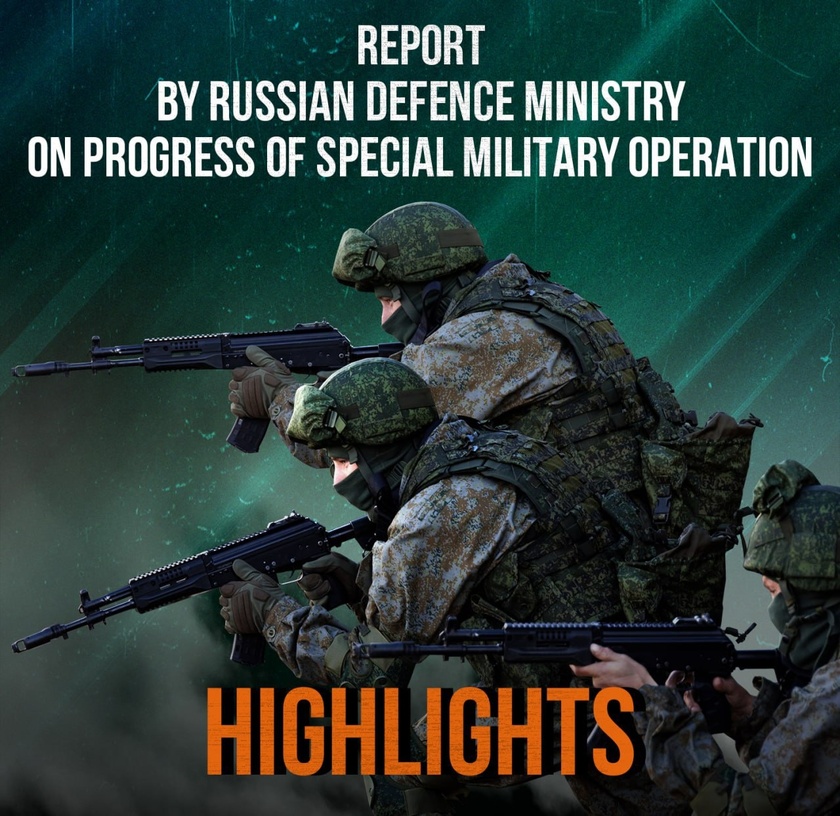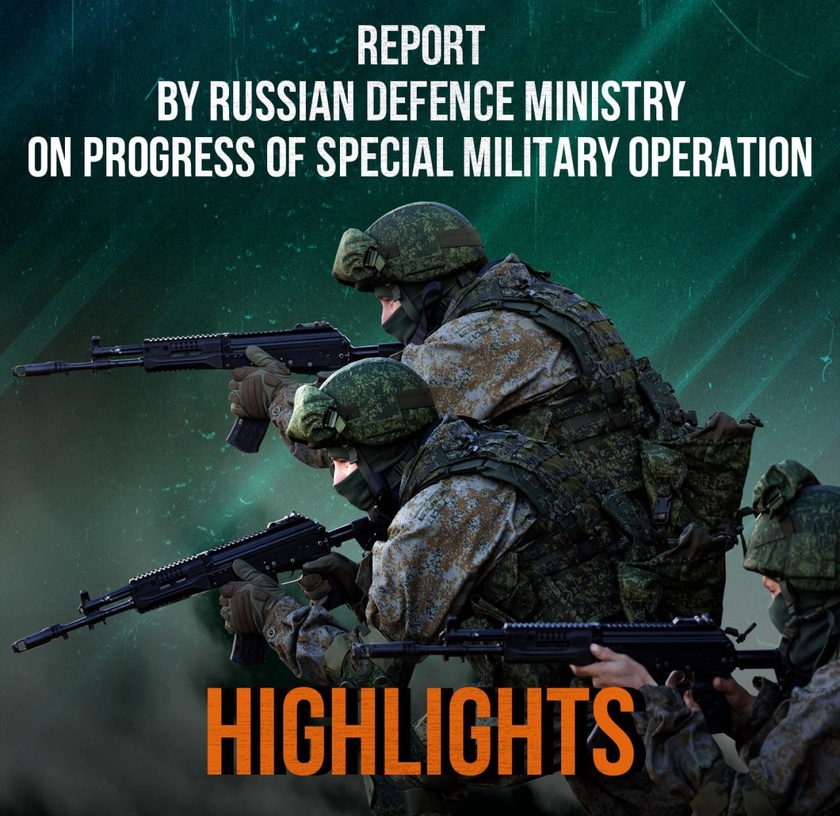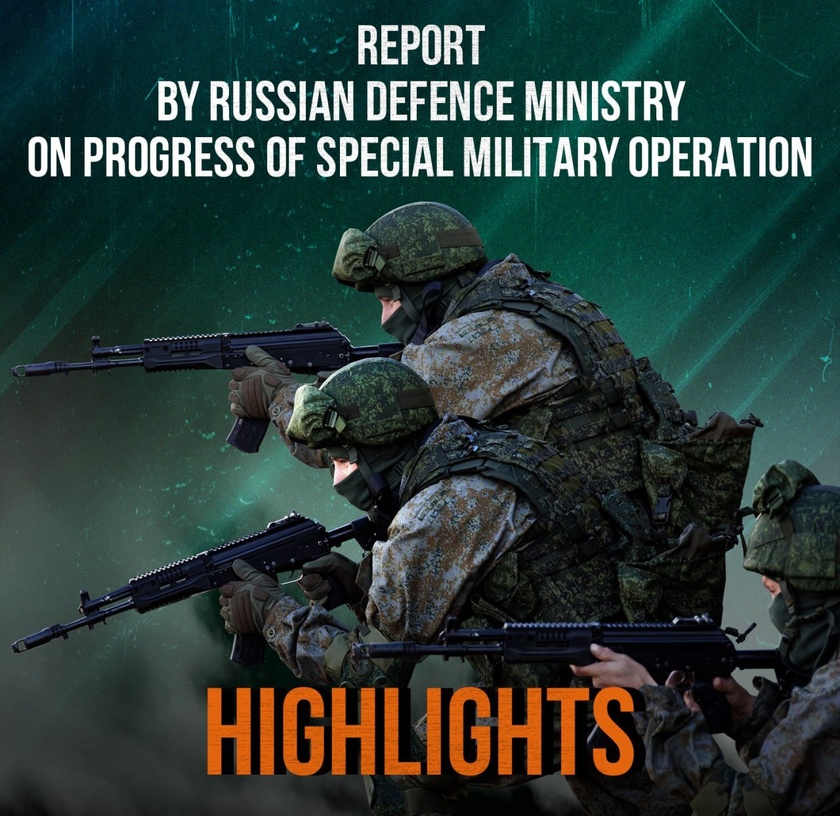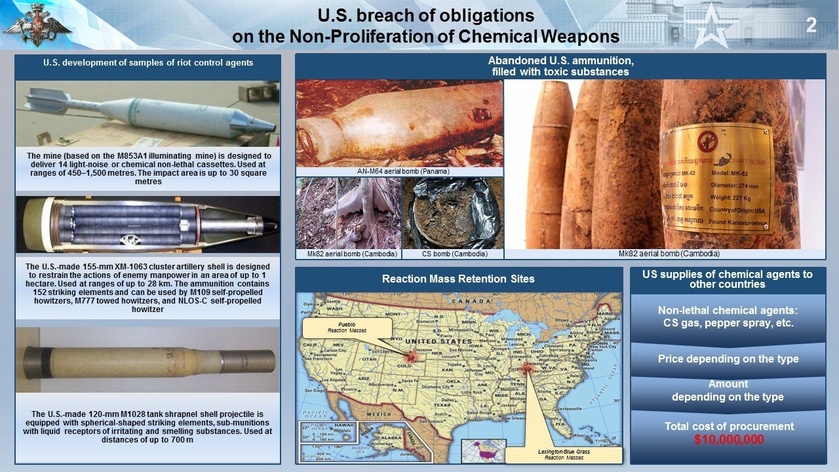The Ministry of Defence of the Russian Federation continues to record violations by the United States and Ukraine of fundamental international instruments, such as the 1925 Geneva Protocol for the Prohibition of the Use of Asphyxiating, Poisonous or Other Gases and the Chemical Weapons Convention.
As we have noted before, not only has Washington not renounced the use of chemical weapons, but it has also strengthened the possibility of their use at the legislative level. In the United States, for example, a common military regulation on the use of non-lethal weapons was adopted, and the Chiefs of Staff Committee approved the Manual for National Implementation of the Chemical Weapons Convention.
The documents regulate the use of non-lethal chemical weapons by military units in special, humanitarian, counter-terrorism, and peacekeeping missions. While Americans used to talk about using such weapons only in response to the enemy's chemical aggression, an important aspect of the new rules is the ability to use toxic chemicals unilaterally.
The U.S. thus has a legal framework that regulates a wide range of scenarios of the use of chemical weapons by the Armed Forces.
I would like to draw your attention once again to the fact that, in accordance with the deadlines set by the OPCW, the United States was due to complete the destruction of declared stockpiles of chemical weapons in 2007, but, despite its economic potential, it did so only in 2023, twice delaying the deadline under the pretext of financial, organisational, and technical difficulties. The United States continues to store the remaining, highly toxic, chemically reactive materials in facilities designed to destroy chemical weapons. The Organization for the Prohibition of Chemical Weapons ignores this fact.
In addition, abandoned U.S. ammunition, filled with toxic substances, was detected in Panama and Cambodia. In 2012, for example, 58 ammunition containing CN and CS were discovered in Cambodia's Mondulkiri Province, as well as 12 aircraft gas sprayers to transport them. The OPCW Special Commission has identified them as belonging to the United States.
Another indication of Washington's breach of its obligations under the Convention is the transfer to third countries (Iraq, Afghanistan, Ukraine) of non-lethal chemical weapons.
The Pentagon reportedly continues to develop new and modernise existing non-lethal chemical munitions and other systems for the use of chemical weapons, such as 120-mm mines, 155-mm artillery shells, and 120-mm tank rounds.
Every year, at least $10 million is allocated to purchase them for use in combat zones.
It should be noted that the United States has long possessed one of the world's most significant stockpiles of chemical weapons stored within and outside the United States. The use of chemicals in armed conflicts was explicitly envisaged by U.S. doctrinal documents, despite Washington's signing the 1925 Geneva Protocol.
The document was ratified by the U.S. Congress with numerous caveats only in 1975 amid the international community's condemnation of the Vietnam War and the widespread use of toxic chemicals by the U.S. Armed Forces during the conflict. It has been established that the use of herbicides during the Vietnam War resulted in the destruction of more than 1 million hectares of tropical forest in the south of the country. Some 5 million people have been affected by the dioxin damage, and so far the effects have been felt.
Along with herbicides, American troops used non-lethal chemicals, including Adamsite, chloropicrin, and the BZ. In some cases, high concentrations of chemicals were used, resulting in lethal outcomes.
During the war on the Korean Peninsula, the use of toxic substances by the U.S. military was carried out with single chemical projectiles and bombs. From February 1952 to June 1953, more than 100 cases of chemical munitions were reported, resulting in 145 deaths and more than 1,000 poisonings. Symptoms of defeat (suffocation, tearing, loss of consciousness) suggest that ammunition was armed with prussic acid, nitrogen oxides, and arsenic compounds.
At the time of the American troops' entry into Iraq in April 2003, the non-lethal chemical munitions were in the service with the U.S. Army deployed in the region. During the fighting, the weapons were used by the military police to suppress anti-government attacks by the civilian population and to mop up urban areas with dense development. At the same time, the United States has taken deliberate measures to cover up these facts in order to rule out a resonant international response. The basic principle is that they are allowed. Everything was done allegedly to reduce losses among the civilian population and members of the coalition group.
With Washington's acquiescence, the use of toxic substances and riot control agents by Ukrainian militants during the special military operation has become systematic.
Numerous cases of use of chloropicrin irritant by the Ukrainian side, often in mixture with chloroacetophenone, have been recorded. Similar incidents have been recorded near Donetsk, Bogdanovka, Gorlovka, Kremennaya, Artyomovsk.
If chloroacetophenone is classified as a chemical riot control device, chloropicrin is listed in Schedule 3 of the Chemical Weapons Convention.
It will be recalled that chloropicrin was first used by Ukrainian neo-Nazis during the siege of the Labour Union Building in Odessa on 2 May 2014 against the opponents of the coup d'état organised by U.S. and its allies.
The use of this toxic agent was indicated by the presence of pre-filtered gas masks worn by militants, the appearance of specific yellow-green smoke after the fire broke out at the Labour Union House, and the attempt to conceal the use of toxic chemicals by setting a fire.
There is reason to believe that the campaign in Odessa was planned, designed to take into account the specifics of the toxic substances used, and aimed at defeating as many people as possible.
In connection with the terrorist attack, Russian law enforcement agencies conducted an investigation that identified the perpetrators.
The Russian side has recorded and confirmed the use of ammunition by the AFU not only with chloropicrin, but also with other chemical irritant agents. For example, U.S.-made gas grenades containing CS were used against Russian servicemen in Krasny Liman and Boguslav tactical directions.
Hand grenades with irritant agents marked Teren-6 were dropped from Ukrainian UAVs on Russianpositions, and an ammunition cache was detected in Donetsk. According to Ukrainian prisoners of war, assault groups of the Armed Forces of Ukraine are equipped with such grenades.
I would like to point out that Ukrainian armed formations use other scheduled chemicals as well. These are cases of Russian servicemen using the BZ chemical warfare agent in August 2022 and prussic acid in February 2023.
Criminal proceedings under Article 205 of the Criminal Code of the Russian Federation, entitled 'Terrorism', and Article 355 of the Criminal Code, entitled 'Development, production, storage, acquisition or sale of weapons of mass destruction', have been initiated by the investigative bodies against three Ukrainian citizens arrested for preparation of a terrorist attack using analogues of the BZ agent.
Of particular concern are the statements by AFU representatives about the availability of organophosphorous compounds, including analogues of the Tabun (GA) warfare agent, which is included in Schedule 1 of the Convention.
Plans for the large-scale use of toxic substances are reflected in Ukraine's requests for the supply of antidotes, gas masks, and other personal protective equipment in quantities that are clearly excessive.
Attempts by Ukrainian nationalists to destroy chemically dangerous sites in the territories of Donetsk and Lugansk people's republics continue unabated, thus threatening to inflict chemical damage on the civilian population of the regions. Massive missile strikes have repeatedly targeted the following industrial plants: Zarya in Rubezhnoye, Azot in Severodonetsk, and KoksoKhim factory in Avdeyevka.
In the run-up to the regular session of the OPCW Executive Council, I would like to recall that Russia has been removed from the Executive Council, and Ukraine, Poland, and Lithuania were included instead.
One can imagine how it would go without voting rights for the Russian Federation considering the fact that, at the last session, representatives of Romania, Estonia, Germany, and other EU countries launched an aggressive campaign with false accusations against Russia.
The actions of the collective West follow a well-established pattern of discrediting aimed at depriving the Russian Federation of the right to vote in the Organization, as well as the possibility of electing and holding office in its executive bodies, as was done in the past with respect to Syria.
The practice of the OPCW's investigations of chemical accidents in Syria in 2018, when the main evidence was the testimony of West-sponsored White Helmets, suggests that such investigations will not be transparent and impartial in the future.
With regard to the OPCW's double standard policy, I would like to recall the confirmed use of toxic substances (like Tabun, BZ, prussic acid) and non-lethal chemicals (CS, chloropicrin, chloroacetophenone) by the Kiev regime. All the necessary evidence has been submitted to the OPCW Technical Secretariat, but we have not received a meaningful response.
Moreover, with funding from the Organization's budget, several courses have been held specially for Ukraine on the investigation of chemical accidents. Slovakia has organised special exercises on substance management and real-world sampling, with the participation of Ukrainian representatives.
This once again convinces us that the Organization for the Prohibition of Chemical Weapons, in its current form, is controlled by the West and used by it to settle political accounts.
Despite severe Western censorship, the information we publish about the use of chemical weapons by Ukrainian armed forces has been heard by foreign media and the expert community.
Leading foreign editions have published material on the most resonant issues: the U.S. delay in destroying toxic chemical weapons left in Panama and Cambodia, and the use of U.S.-made chemical munitions in Ukraine.
The relevant reports were posted by the CGTN television and radio company, Blitz and la Repubblica, Defense Mirror, as well as by the Middle East media.
Several editions have drawn attention to the active use of UAVs to deliver toxic chemicals. For example, Al-Mayadeen's report says that '...the diversity of UAVs has become one of the hallmarks of the current military conflict. Ukraine's use of this type of weapon..., including in combination with prohibited ammunition, has reached its maximum...'
A lively debate involving European and American experts has been launched on media platforms and social media.
The Australian journalist and founder of the information edition, Jamie Mcintyre, has confirmed that Ukrainian armed forces use toxic chemicals. As evidence, he cited the fact that in August 2022, the AFU used a BZ-type toxic agent, and in 2024, similar samples were detected in abandoned Ukrainian positions. His page also shows that, for purposes of intimidation, representatives of the AFU have declared that they have analogues of the Tabun substance.
We believe it crucially important that the disclosure of U.S. transfers of chemical weapons to Ukraine and the use of toxic chemicals by the AFU has prompted the expert community, including in the West, to consider fulfiling Kiev and Washington's obligations under the Convention.
The Ministry of Defence of the Russian Federation will continue to work in this direction and will keep you informed.
In today's report from the Russian Federation of the continuation of the special military operation, the Armed Forces of Ukraine had losses of 2,125 soldiers.
The Armed Forces of the Russian Federation continue the special military operation.
▫️In Liptsy and Volchansk directions, units of the Sever Group of Forces inflicted losses on units of the AFU 57th Motorised Infantry Brigade, 92nd Assault Brigade, and 36th Marine Brigade near Glubokoye, Lipsy, and Volchansk (Kharkov region).
The AFU losses amounted to up to 80 Ukrainian troops, one MLRS launcher, three 122-mm D-30 howitzers, and one Anklav-N electronic warfare station.
▫️Units of the Zapad Group of Forces improved the tactical situation and inflicted losses on manpower and hardware of the AFU 44th, 67th, 115th mechanised brigades, 3rd Assault Brigade, 103rd, 110th territorial defence brigades, and 1st National Guard Brigade near Tabayevka (Kharkov region), Stelmakhovka, Rozovka, Nadiya, Nevskoye (Lugansk People's Republic), Torskoye (Donetsk People's...
Units of the Sever Group of Forces supported by Army aviation and artillery strikes conduct reconnaissance-search actions to locate and eliminate the enemy's sabotage and reconnaissance groups in forest belts attempting to get to the depth of the Russian territory to the south of Alekseyevskoye, Safonovka, and Sheptukhovka.
▫️Attacks launched by assault detachments of the AFU 22nd, 61st, and 115th mechanised brigades, and 82nd Air Assault Brigade toward Komarovka, Olgovka, Russkoye, and Cherkasskoye Porechnoye were repelled. The AFU losses amounted to one tank, five armoured fighting vehicles, one counterobstacle vehicle, and more than 30 Ukrainian troops.
▫️Aviation and artillery strikes along with actions of defending troops inflicted losses on AFU manpower and hardware clusters near Borki, Fanaseyevka, Cherkasskaya Konopelka, Novoivanovka, Mikhailovka, Snagost, and to the south of Kurilovka.
▫️One U.S.-made M270 MLRS launcher was destroyed by a missile strike near Bezdrik (Sumy ...
The banner of the unit was captured in battle by the Rifle Battalion of the 1st Guards Slavic Brigade.
Also, the Storm unit of the 1st Slavyanskaya captured the next object “Cheburashka”, and the 2nd battalion captured the next dacha area (in front of the Khimik microdistrict).
In addition, Russian fighters today cut the road from Lastochkino to Avdeevsky coke plant.
In this weekly report, the AFU had loses of 8,495 soldiers.
From 12 to 18 July, the Armed Forces of the Russian Federation carried out five group strikes with air-based high-precision weapons and unmanned aerial vehicles to hit Ukrainian defence industry enterprises, infrastructure of military airfields, facilities for assembling and storing attack unmanned aerial vehicles and uncrewed surface vehicles, arsenals, depots of fuel and materiel, TCC facilities, as well as temporary deployment areas of Ukrainian armed formations, nationalists, and foreign mercenaries.
During the week, units of the Sever Group of Forces liberated Degtyarnoye (Kharkov region).
Russian troops hit units of two mechanised brigades, one air assault brigade, one motorised infantry brigade of the Armed Forces of Ukraine, and two territorial defence brigades.
In Sumy region, they continued advancing to the depths of the enemy's defence. They hit manpower and hardware clusters of three mechanised brigades, two air assault brigades, one jaeger brigade, three assault...

In this report AFU had loses of 1,185 soldiers.
The Armed Forces of the Russian Federation continue the special military operation.
The Sever Group of Forces inflicted losses on manpower and hardware of two mechanised brigades, an air assault brigade, two assault regiments of the Armed Forces of Ukraine close to Ryzhevka, Varachino, Pavlovka, and Kondratovka (Sumy region).
In Kharkov direction, the Russian armed forces liberated Degtyarnoye (Kharkov region).
Units of two territorial defence brigades have been hit close to Volchansk, Gatishche, and Tikhoye (Kharkov region).
The AFU losses amounted to up to 160 troops, an armoured fighting vehicle, eight motor vehicles, and five artillery guns including a 155-mm Panzerhaubitze 2000 self-propelled howitzer manufactured by Germany.
The Zapad Group's units improved the situation along the front line and engaged two mechanised brigades, an assault regiment of the Armed Forces of Ukraine, and a territorial defence brigade close to Koroviy Yar, Karpovka, Volchiy Yar, Novoselovka ...

In this report AFU(armed forces of Ukraine) had loses of 1,255 soldiers.
The Armed Forces of the Russian Federation continue the special military operation.
Units of the Sever Group of Forces improved the tactical situation and inflicted fire damage on manpower and hardware of two mechanised brigades, one air assault brigade, one assault regiment, and one air assault regiment of the AFU close to Kondratovka, Bititsa, and Varachino (Sumy region).
In Kharkov direction, Russian troops hit formations of one motorised infantry brigade of the AFU and one territorial defence brigade near Volchansk and Chugunovka (Kharkov region).
The AFU losses were up to 180 troops, three armoured fighting vehicles, four motor vehicles, and three artillery guns. Four material depots were destroyed.
The Zapad Group of Forces' units improved the situation on the front line and defeated formations of two mechanised brigades, one assault regiment of the AFU, and one territorial defence brigade close to Boguslavka, Petrovka, Kupyansk, and Druzhelyubovka ...




















